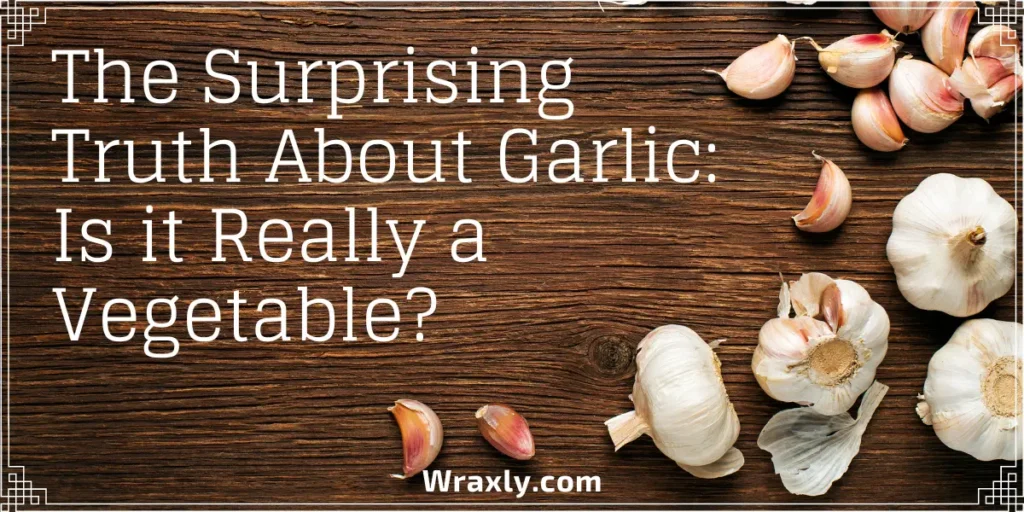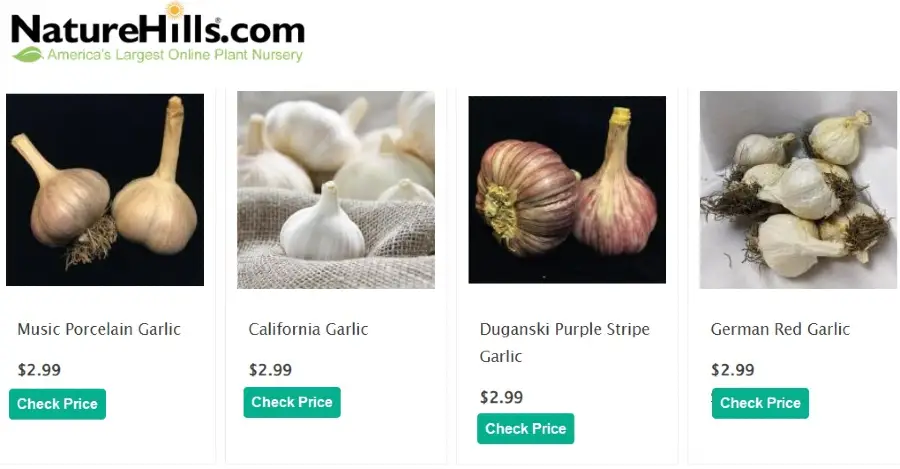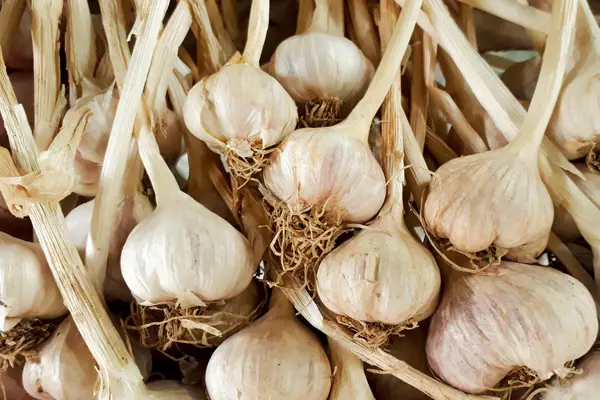Garlic is a staple in many kitchens, but do you know if it’s a vegetable or not?
The answer is both yes and no! Garlic is technically considered to be a herb, but can also be classified as a vegetable depending on how it’s used.
In this post, we’ll explore the answer to the question – is garlic a vegetable or not?

Defining Key Terms
To break down what garlic is and how people use it, we’ll need to look at the origins and definitions of a vegetable and an herb. Both terms originate from Latin and refer to different aspects of plants.
What Is a Vegetable?
The term vegetable originates from the Latin word “vegetus,” meaning “vigorous” or “lively.” Vegetables are the part of a plant that humans consume as food, including leaves, stems, roots, bulbs, flowers, and seeds. Whether raw or cooked, vegetables can be a snack, an accompaniment to the main meal, or the main meal itself. No matter how you prepare them, vegetables provide essential vitamins, minerals, and fiber as a key part of a healthy diet.
What Is an Herb?
The term “herb” comes from the Latin word “herba” which means “grass” or “green plants,” so “herbs” came to mean “green vegetables.” People describe the edible leaves or flower parts used in cooking and gardening as herbs. Science defines herbs as plants that lack a woody stem. The main difference between herbs and other plants is their harvesting methods.
However, in the culinary world, the definition of an herb makes the classification of garlic a bit murkier. Herbs are highly versatile, and that’s why people use them in various dishes to add flavor, aroma, and texture.
Scientific vs. Culinary Classification of Garlic
The debate as to whether garlic is a vegetable or an herb comes into full force when you compare how the fields of science and the culinary arts each classify it because you quickly learn that garlic can be either a vegetable or an herb. Depending on which one you align more with will ultimately decide how you classify garlic.
The Scientific Classification of Garlic
Garlic has a rich history; it is one of the oldest plants to be cultivated, with its roots tracing back to Asia Minor over 6,000 years ago. It is a bulb-growing plant that is part of the Allium family. Alliums, also known as ornamental onions, include shallots, chives, scallions, leeks, and onions.
The life cycle of garlic is two years, making it a perennial plant. For the first year, it grows as a single clove planted in the ground. The following year it produces a flower stalk and seeds. People replant the seeds once they have collected them for the next season.
The Culinary Classification of Garlic
If we examine the culinary definition of garlic, it’s clear that it could easily fit into either the herb or the vegetable category. For example, people commonly serve the classic combination of garlic and parsley with fish as part of a traditional Mediterranean diet. This suggests that people widely use garlic as an herb.
On the other hand, roasted garlic is often added to soups, stews, and salads, and this behavior means that garlic could also be a vegetable.

Species and Subspecies
Regardless of which classification of garlic you choose, we can agree that it is part of the Alliaceae family. As such, it is also known as Allium Sativa. Despite more than 100 garlic species and subspecies in existence, people tend to cultivate certain types over others, and these are usually classified as hard-neck or soft-neck.
The garlic you usually find in the supermarket is a subspecies of the “long-rooted hard-neck garlic.” It is native to Central Asia and parts of North America and Europe.
There are two other common species of garlic, known as “A. ophioscorodon” and “A. uranium.” Both of these kinds of garlic are known as “soft-neck garlic.”
Hard-Neck Garlic
Hard-neck garlic is the most popular garlic grown worldwide, and people often use it for culinary purposes. They have large, thick, dry bulbs with little or no ground cloves. Instead, a ring of internal shoots contains the cloves. Because of its strong flavor, people frequently use hard-neck garlic as a condiment in food. It’s also the best choice for garlic-infused oils because the cloves are more concentrated than other types of garlic.

Soft-Neck Garlic
People consider soft-neck garlic to be milder and more delicate than hard-neck garlic. Its thin, moist bulbs have many cloves and can also be used in cooking. Soft-neck garlic has a high sugar content and is usually eaten whole, either raw or roasted. It’s also a good option for garlic-infused oils.
Unlocking the Benefits of Garlic: How This Superfood Can Improve Your Health
Garlic is one of the oldest known superfoods, and its health benefits span centuries. It is a powerhouse of antioxidants, minerals, and vitamins, making it one of the most potent natural remedies available.
Unlocking the health advantages of garlic is a crucial first step in enhancing your well-being. Garlic has several beneficial effects on your health, from preventing infections to lowering chronic inflammation. It also helps strengthen your immune system and reduces your risk of heart disease. This superfood can help improve your overall wellness and provide various health benefits. Learn how to incorporate garlic into your diet and discover how it can benefit your health.
Nutritional Benefits of Garlic
- Vitamin B6
This vitamin is crucial for adequately functioning the brain and nervous system. It also helps to support a healthy metabolism and energy production.
- Vitamin C
This vitamin is an important antioxidant and a natural disinfectant. It is necessary to grow and repair tissues and can support a healthy immune system.
- Folate
This B vitamin is necessary for a healthy cardiovascular system, neural development, and DNA production. It can also help to lower the risk of neural tube defects in unborn children.
- Potassium
This mineral is crucial in regulating blood pressure and can help lower blood cholesterol.
- Antioxidants
Garlic’s high levels of antioxidants can help reduce oxidative stress and chronic inflammation, decreasing the risk of developing certain chronic diseases and slowing down the aging process.
Recommended Garlic Supplements
| Image | Title | Prime | Buy |
|---|---|---|---|
 | Odorless Pure Garlic 3000 mg per Serving Maximum Strength 150 Soft gels Promotes Healthy Cholesterol Levels Immune System Support | PrimeEligible | Check My Price on Amazon |
Top | Puritan's Pride Odorless Garlic 1000 Mg Rapid Release Softgels, 250Count | PrimeEligible | Check My Price on Amazon |
 | BRI Nutrition Odorless Garlic - 120 Softgels - 1000mg Pure and Potent Garlic Allium Sativum Supplement (Maximum Strength) - 60 Day Supply | PrimeEligible | Check My Price on Amazon |
 | Odorless Garlic Softgels | 250 Count | Ultra Potent Garlic Extract | Non-GMO & Gluten Free Pills | by Horbaach | PrimeEligible | Check My Price on Amazon |
 | Puritans Pride Garlic Oil, 5000 Mg, 250 Count | PrimeEligible | Check My Price on Amazon |
 | Garlique Garlic Extract Supplement, Healthy Cholesterol Formula, Odorless & Vegan, 60 Caplets | PrimeEligible | Check My Price on Amazon |
 | Kyolic Aged Garlic Extract Formula 100, Original Cardiovascular, 300 Capsules (Packaging May Vary) | PrimeEligible | Check My Price on Amazon |
Health Benefits of Garlic
- Boosts Immunity
Research shows that Aged-garlic extracts effectively boost immune system function. Daily doses of garlic may decrease the chance of infections.
- Reduces Risk of Heart Disease
Another benefit of aged garlic is its ability to lower the risk of heart disease. Garlic is rich in dietary fiber and compounds such as flavonoids and allicin, which have cholesterol-lowering properties.
- Protects Against Cancer
Studies indicate that garlic can help to prevent a wide range of cancers. It contains several beneficial compounds that have been shown to reduce the risk of developing cancer.
- Helps Lower Blood Pressure
Another benefit of garlic is that it may lower blood pressure. Studies have shown that you can use it in conjunction with other treatments to help lower blood pressure.
How to Add Garlic to Your Diet
There are several ways to add garlic to your diet. Sprouted garlic is an excellent source of raw garlic. It contains higher levels of natural antioxidants that can help prevent infections by boosting your immune system.
Most people prefer cooked garlic as it can be milder in flavor. Cooking garlic can enhance the bioavailability of its composition, which ultimately leads to increased health benefits.
For example, roasted garlic and garlic-based sauces are tasty ways to include garlic in your diet.
FOR FURTHER READING
- How to Plant Garlic in a Pot
- Choosing the Right Plants for Container Gardening
- Building a Raised Garden
- How to Grow Sunflowers in a Pot
Side Effects and Precautions
The allicin in garlic can cause a few unpleasant symptoms, such as gastrointestinal discomfort and a burning sensation in the mouth. These sometimes heighten when consuming it in raw form. You can reduce the taste and any adverse side effects by eating garlic after lightly cooking it.
Generally, cooked garlic is safe to consume, even when breastfeeding or pregnant. However, due to the risk of potential adverse side effects, pregnant women should avoid overeating raw garlic.
Finally, some studies have suggested that garlic may have anti-inflammatory and anticoagulant properties, meaning it could potentially increase bleeding. Still, there needs to be further research to answer this question definitively.

Final Thoughts: Is Garlic a Vegetable?
Many research studies consider garlic as a vegetable because it is part of the Allium family, alongside other notable vegetables such as onions, leeks, and shallots. Garlic has a strong, spicy taste that, as it cooks, mellows and becomes sweeter.
Garlic is technically a vegetable, but people more frequently use garlic to flavor dishes rather than eating it on its own. Cooks widely use garlic for its intense flavor, which adds a unique taste and smell to various dishes.
Additionally, garlic is highly nutritious and contains essential vitamins, minerals, and antioxidants. Specifically, garlic is a good source of vitamin B6, selenium, vitamin C, manganese, and dietary fiber. Anti-inflammatory and antimicrobial properties in garlic can help fight off infections and reduce inflammation in the body.

Darrell has a passion for gardening that he inherited from his father. Go here to read more about the influence his father played in his love for gardening. If you want to send Darrell a quick message, then visit his contact page here.

![How to Water Indoor Plants [Plant Care 101]](https://wraxly.com/wp-content/uploads/2021/03/How-to-Water-Indoor-Plants-Plant-Care-101-1200-1024x576.webp)

![Growing Plants from Cuttings [A Simple Guide]](https://wraxly.com/wp-content/uploads/2021/03/Growing-Plants-from-Cuttings-A-Simple-Guide-1200-1024x576.webp)